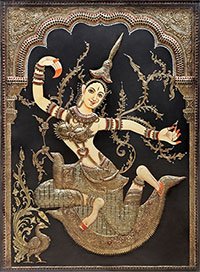Shyenadhara, Śyenadhara, Shyena-dhara: 1 definition
Introduction:
Shyenadhara means something in Hinduism, Sanskrit. If you want to know the exact meaning, history, etymology or English translation of this term then check out the descriptions on this page. Add your comment or reference to a book if you want to contribute to this summary article.
The Sanskrit term Śyenadhara can be transliterated into English as Syenadhara or Shyenadhara, using the IAST transliteration scheme (?).
In Hinduism
Sports, Arts and Entertainment (wordly enjoyments)
Source: archive.org: Syainika Sastra of Rudradeva with English Translation (art)Śyenadhara (श्येनधर) refers to a “hawker” (i.e., one carrying a hawk while hunting), according to the Śyainika-śāstra: a Sanskrit treatise dealing with the divisions and benefits of Hunting and Hawking, written by Rājā Rudradeva (or Candradeva) in possibly the 13th century.—Accordingly, [while discussing the outlines of hawking]: “[...] At the middle of the party there should be the leading hawker (śyenadhara) [madhye śyenadharo netā], with two soldiers on each side. The circle should be made with twenty-one horsemen. All men in the circle, with their eyes fixed on the chief hawker, should remain at a distance of four cubits from each other, in two equal divisions on each side. [...]”.

This section covers the skills and profiencies of the Kalas (“performing arts”) and Shastras (“sciences”) involving ancient Indian traditions of sports, games, arts, entertainment, love-making and other means of wordly enjoyments. Traditionally these topics were dealt with in Sanskrit treatises explaing the philosophy and the justification of enjoying the pleasures of the senses.
See also (Relevant definitions)
Relevant text
No search results for Shyenadhara, Śyenadhara, Śyena-dhara, Shyena-dhara, Syenadhara, Syena-dhara; (plurals include: Shyenadharas, Śyenadharas, dharas, Syenadharas) in any book or story.